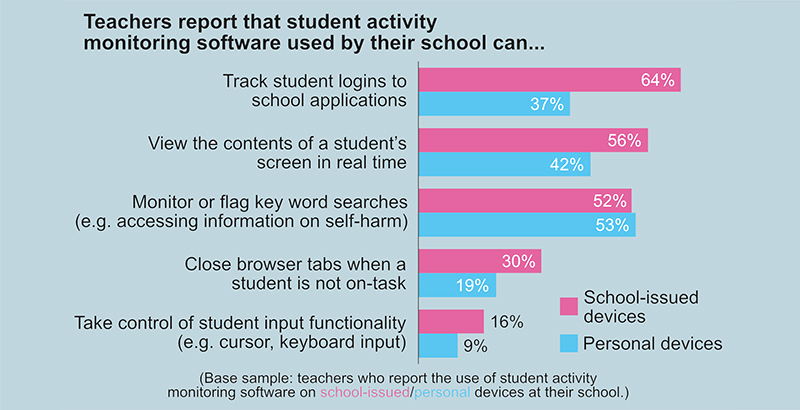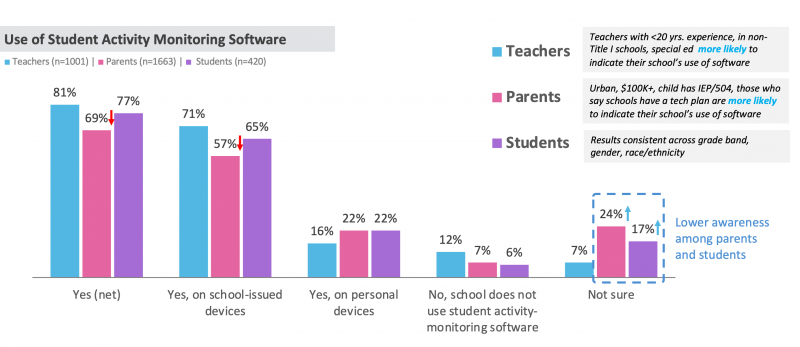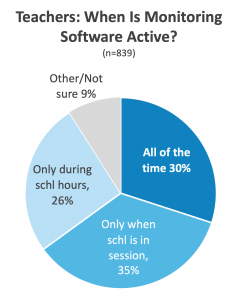New Research: Most Parents and Teachers Have Accepted Student Surveillance As a Safety Tool — But See the Potential For Serious Harm

Get stories like these delivered straight to your inbox. Sign up for The 74 Newsletter
Tools that monitor students’ online behavior have become ubiquitous in U.S. schools — and grew rapidly as the pandemic closed campuses nationwide — but a majority of parents and teachers believe the benefits of such digital surveillance outweigh the risks, according to research released Tuesday.
Similarly, half of students said they are comfortable with schools’ use of monitoring software while a quarter reported feeling queasy about the idea, according to the new research by the Center for Democracy and Technology, a nonprofit group based in Washington, D.C. Despite their overall comfort with digital software, teachers, parents and students each worried about how the tools could have detrimental side effects. Specifically, many parents and teachers were concerned that digital surveillance could be used to discipline students and young people reported becoming more reserved when they knew they were being watched.
“In response to the pandemic, the focus on technology and its use has never been greater,” said report co-author Elizabeth Laird, the center’s director of equity in civic technology. As tech gains a greater grasp on education, she said it’s important for school leaders and policymakers to remain focused on protecting students’ individual rights. She worried that student surveillance technology could have a damaging impact on students, especially youth of color and those from low-income households.
“I don’t think it’s a slam dunk,” Laird said.
Though the report didn’t highlight specific tools used, schools deploy a range of digital monitoring software to track student activity, including programs that block online material deemed inappropriate, track when students log into school applications, and allow teachers to view students’ screens in real-time and even take control of their computers.
Last week, an investigative report by The 74 exposed how the Minneapolis school district’s use of the digital surveillance tool Gaggle had subjected children to relentless online surveillance long after classes ended for the day — including inside students’ homes. Through artificial intelligence and a team of content moderators, Gaggle tracks the online behaviors of millions of students across the U.S. every day by sifting through data stored on their school-issued Google and Microsoft accounts. In Minneapolis, the company flagged school security when moderators believed students could harm themselves or others, but it also picked up students’ classroom assignments, journal entries, chats with friends and fictional stories.
Among teachers surveyed by the Center for Democracy and Technology, 81 percent said their schools use software that tracks students’ computer activity, including to block obscene material, monitor students’ screens in real time and prohibit students from using websites unrelated to school like YouTube. A majority of both parents and students reported such tools were used in their schools, but they were also more likely than teachers to be unsure about whether youth were being actively monitored by educators. In interviews with administrators, researchers found that many school leaders weren’t sure how best to be transparent with families about their monitoring practices.
“Certainly there is an imbalance in information and transparency around what is happening,” Laird said. School districts have been clear [that] students shouldn’t have an expectation of privacy but they haven’t been as clear about what they are tracking, how they are tracking it, how long they keep that information. They really should be doing that.”

Among teachers, 66 percent said the benefits of activity monitoring outweigh student privacy concerns and 62 percent of parents reached a similar conclusion. Meanwhile, 78 percent of teachers reported that digital surveillance helps keep students safe by identifying problematic online behaviors and 72 percent said it helps keep students on task. But their answers also revealed equity concerns: 71 percent of teachers reported that monitoring software is applied to all students equally, 51 percent worried that it could come with unintended consequences like “outing” LGBTQ students and 49 percent said it violates students’ privacy.
Many teachers reported that such monitoring tools are used on students long after classes end for the day. In total, 30 percent of educators said the tools are active “all of the time,” and 16 percent said the software tracks kids on their personal devices.

Among parents, 75 percent said digital surveillance helps keep students safe and 73 percent said it ensures children remain focused on schoolwork. Yet many parents also reported potential downsides: 61 percent worried of long-term harm if the tools were used to discipline students, 51 percent were concerned about unintended consequences and 49 percent said it violates students’ privacy rights.
Perhaps unsurprisingly, students were less at ease with educators watching their online behaviors. Half said they were comfortable with monitoring tools, a quarter said they were uncomfortable with them and another quarter were unsure.
The data also suggest that students alter their behaviors as a result of being watched: 58 percent said they don’t share their true thoughts or ideas online as a result of being monitored at school and 80 percent said they were more careful about what they search online. While just 39 percent of students said it was unfair that educators monitored their school-issued services, 74 percent opposed the surveillance of their own devices like their cell phones. Companies that monitor students’ social media accounts are among those that could track students’ behaviors on their own technology.
The data raise significant equity concerns. For many students, school-issued devices are their only method of connectivity.
“The privacy and security of personal devices is a luxury not all can afford,” Alexandra Givens, the center’s president and CEO, said in a press release. “Constant online monitoring — especially of students who cannot afford or don’t have access to personal devices — risks creating disparities in the ways student privacy is protected nationwide.”
To reach its findings, researchers conducted online surveys in June that were completed by 1,001 teachers, 1,663 parents and 420 high school students. Researchers also conducted interviews with school administrators to understand their motives in deploying digital surveillance. Among the justifications is the Clinton-era Children’s Internet Protection Act, a federal law that requires schools to monitor students online. But the law also includes a disclaimer noting that the statute does not “require the tracking of internet use by any identifiable minor or adult user.”
Understanding context is critical, Laird said, adding that the law’s authors hadn’t fully envisioned a world where students could be surveilled by artificial intelligence long after classes end for the day.
“What was happening at the time was students were in a school computer lab for part of the day and monitoring meant having an adult walking around a computer lab and physically looking at what was on students’ computer monitors,” she said. But today, she said the statute is being interpreted very differently.
In response, the center, along with the American Civil Liberties Union and the Center for Learner Equity sent a letter to federal lawmakers Tuesday to clarify the law’s stipulations and inform educators it “does not require broad, invasive and constant surveillance of students’ lives online.”
“Systemic monitoring of online activity can reveal sensitive information about students’ personal lives, such as their sexual orientation, or cause a chilling effect on their free expression, political organizing, or discussion of sensitive issues such as mental health,” the letter continued. “These harms likely fall disproportionately on already vulnerable, over-policed and over-disciplined communities.”
Get stories like these delivered straight to your inbox. Sign up for The 74 Newsletter


